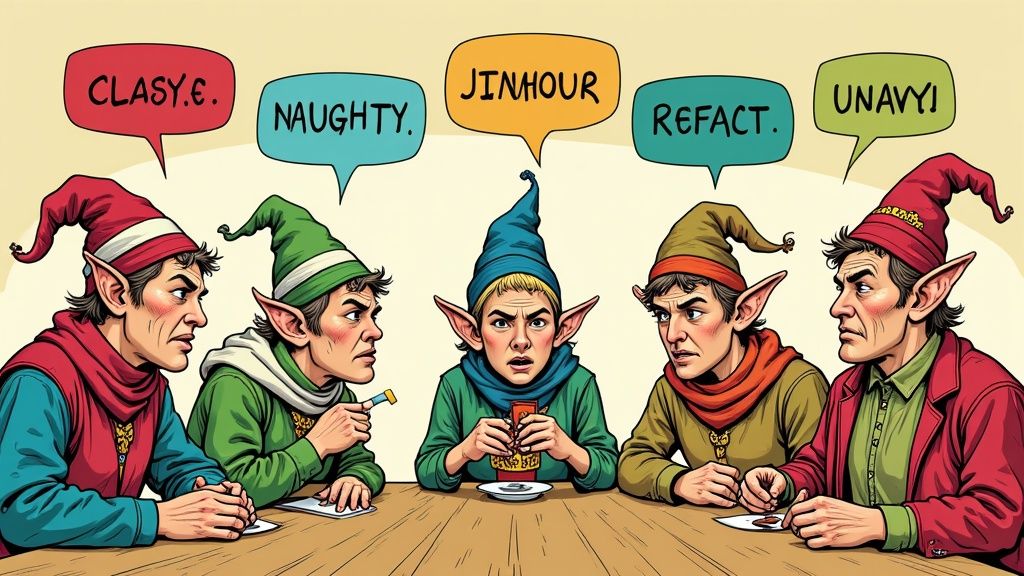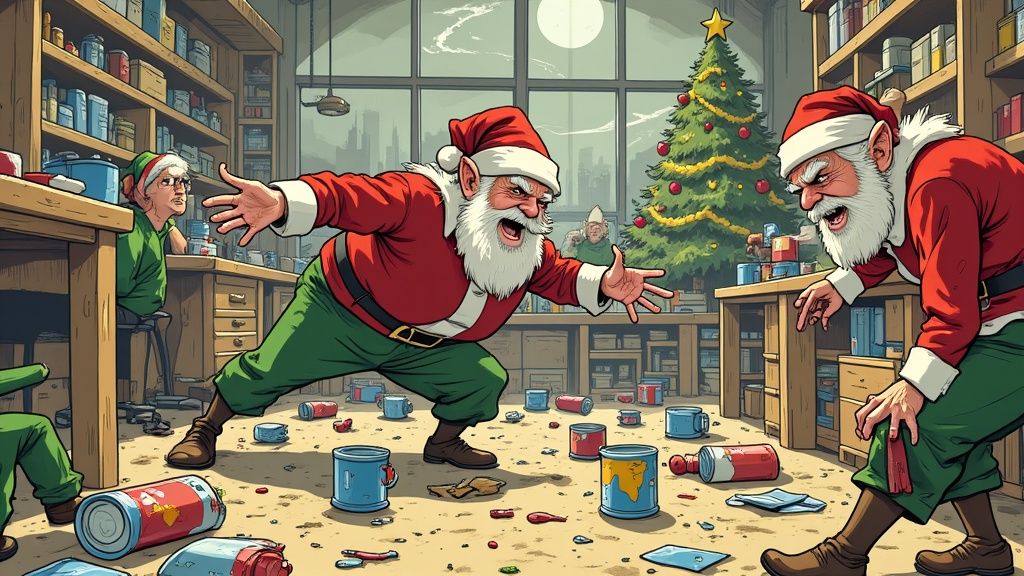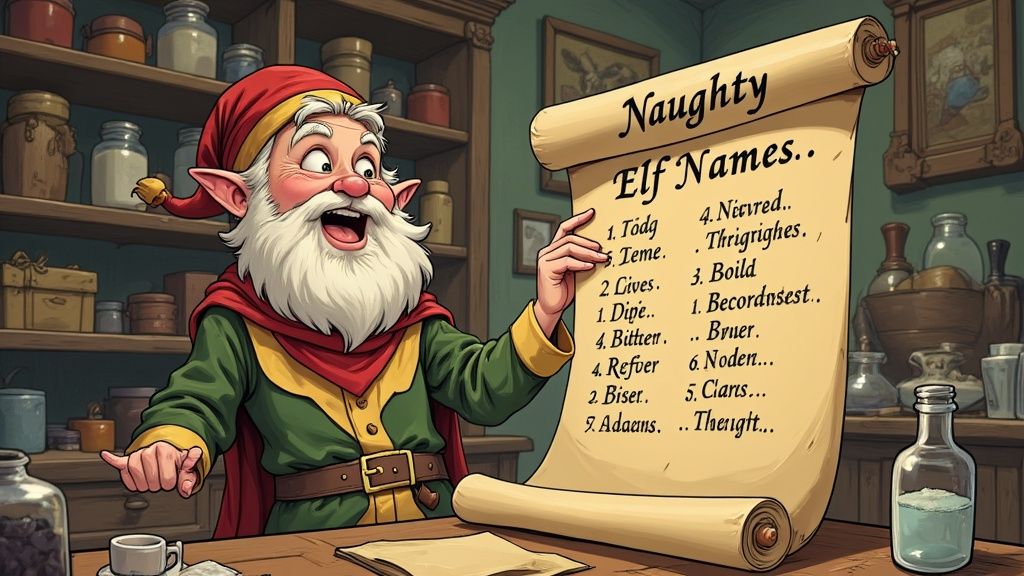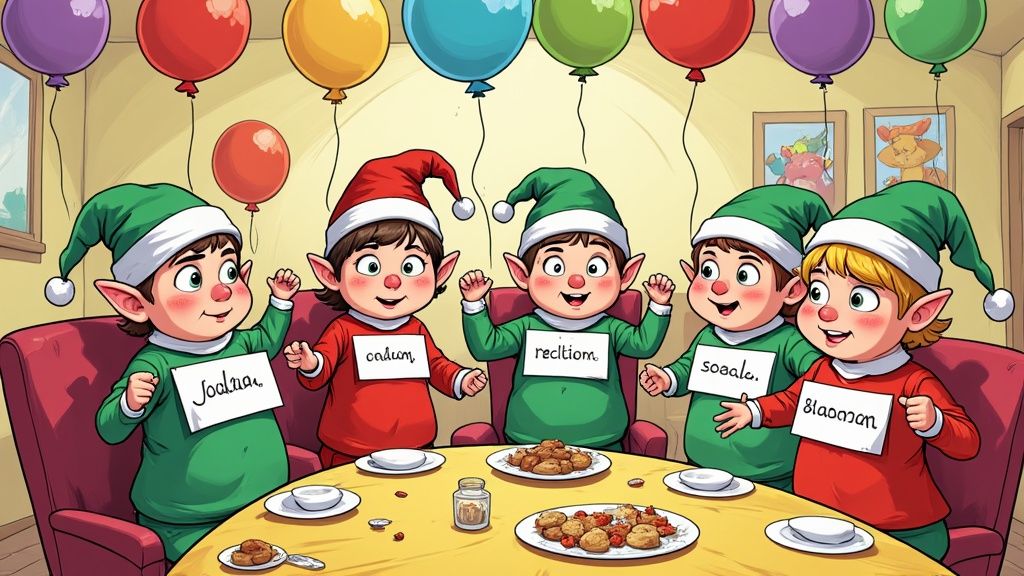Understanding the Dark Allure of Norse Elf Names

Deep within Norse mythology lies a captivating world of mysterious beings – the dark elves, or Dökkálfar. These crafty denizens of Svartalfheim are masters of magic and mischief, making them perfect inspiration for naming naughty elves. Their names, steeped in Old Norse language, carry an otherworldly power that continues to spark imagination today.
The Significance of Sounds and Syllables
Want to know what makes Norse elf names sound so deliciously dark? It's all in the sounds. Take those harsh consonants like "k," "r," and "sk" – they pack a punch that hints at strength and intensity. Just try saying "Shurkan" (meaning "fierce challenger") out loud! Then there's the sneaky sibilance of "s" and "z" sounds, like in "Azaril" ("fiery spirit"), perfect for capturing that sly elfin nature. Mix in some growly endings like "-ar" and "-ik" and you've got names that practically ooze power and mischief.
Reflecting Mythology in Names
Norse elf names aren't just cool-sounding – they tell stories about who these beings are. Many names connect to earth, darkness, and magical abilities. "Erebseth," meaning "shadow in twilight," paints an instant picture of a mysterious figure lurking in the shadows. But here's the thing – being naughty doesn't always mean being evil. Take "Vanikfar" ("seeker of horizons") – it suggests someone who pushes boundaries and breaks rules in the name of adventure. This mix of cunning and curiosity is what makes Norse elf names so perfect for mischief-makers.
Cultural Influence on Modern Fantasy
The magic of Norse mythology hasn't stayed stuck in ancient texts – it's alive and kicking in today's fantasy worlds. Writers and creators often reach back to these old naming patterns when dreaming up their own naughty elf characters. Getting how Norse elf names work helps create modern magical names that feel authentic and rich with meaning. Those special sounds and meanings from Norse tradition give fictional elf names extra oomph, helping readers really connect with the characters.
From Ancient Lore to Modern Mischief
The stories and names from Norse mythology still cast their spell over how we think about elves today. By digging into where these names come from and what they mean, we can better appreciate these fascinating mythological beings. This knowledge is pure gold for anyone wanting to create believable naughty elf names – whether for writing stories, playing games, or just having fun. The dark elves of Norse myth offer endless inspiration for cooking up names that capture that perfect blend of magic and mischief.
The Mischievous Legacy of Iceland's Yule Lads
Remember those tales of Santa's elves helping make toys at the North Pole? Well, Iceland has a rather different take on holiday helpers. Meet the Yule Lads – thirteen trickster spirits who bring both mischief and merriment to the Icelandic Christmas season. Their story offers a fascinating glimpse into how folklore shapes our modern ideas about naughty elves and holiday traditions.
From Fearsome Figures to Festive Friends
Back in the old days, parents didn't use these characters to encourage good behavior – quite the opposite! The Yule Lads started as genuinely scary figures who would come down from their mountain homes to terrorize villages during the darkest winter nights. Each had their own special way of causing trouble, from stealing food to spooking livestock. Just look at their wonderfully descriptive names: Askasleikir would lick unwashed bowls clean, while Gluggagaegir got his kicks from creeping around windows at night. But time has a way of softening even the scariest stories. These once-feared pranksters gradually transformed into the beloved holiday figures that Icelandic children eagerly await today.
A Glimpse into Icelandic Naming Conventions
The Yule Lads' names tell us a lot about traditional Icelandic naming practices. In Iceland, names typically describe something meaningful about a person – their job, personality, or notable deeds. Take Ketkrókur (Meat Hook) and Bjúgnakrækir (Sausage Swiper) – their names paint a vivid picture of their favorite activities! This tradition of meaningful names continues to inspire fantasy writers and creators looking to craft authentic-feeling character names. You might be interested in: Exploring more about Elf naming conventions.
The Yule Lads and Modern Naughty Elves
When you compare Iceland's Yule Lads to modern Christmas elves like the Elf on the Shelf, you can see both similarities and differences. While the Elf on the Shelf watches children to report back to Santa, the Yule Lads are more interested in playful pranks than enforcing good behavior. Their enduring popularity shows how cultural traditions can evolve while keeping their core charm. Today's Icelandic children still leave shoes by their windows for the Yule Lads to fill with small gifts – or potatoes for the naughty! This blend of mischief and magic continues to captivate imaginations and reminds us that sometimes the best holiday traditions are the ones that make us smile.
Mastering the Art of Naughty Elf Name Creation

From the dark elves of Norse myths to Iceland's mischievous Yule Lads, naughty elves have captured imaginations for centuries. Creating names for these playful troublemakers is more than just putting random sounds together – it's about crafting names that bring their impish personalities to life. Let's explore how to make names that perfectly fit these magical pranksters.
Building Blocks of Naughty Elf Names
Just like planning the perfect prank, making a great elf name needs the right ingredients mixed together. Strong sounds like "k," "r," and "sk" work as the foundation – they give names like "Krill" or "Skar" an edge of rebellion and spirit. Adding in slithery sounds like "s" and "z" brings out the sneaky side. Think about "Sizzlewick" – even saying it feels like sharing a secret.
The magic really happens when you balance these sharp sounds with playful endings. Take "Skar" and add "flicker" – now you have "Skarflicker," a name that tells you this elf loves both mischief and fun. This mix of sounds captures how naughty elves dance between causing trouble and spreading joy.
Conveying Mischief Through Meaning
A good elf name should give you a peek at their personality. Starting with words like "Jinx," "Prank," or "Riddle" sets the tone, but the real fun comes from creative combinations. "Jinxspark" suggests an elf who lights up chaos wherever they go, while "Riddleweaver" hints at one who loves confusing others with clever wordplay.
Nature words can add an extra sprinkle of magic too. Names using "Shadow," "Whisper," or "Ember" bring mystery to mind. "Shadowprank" paints a picture of an elf who sneaks around in dark corners, planning their next trick. These nature-inspired touches help root the names in the magical world where elves dwell.
Avoiding Common Pitfalls
While it's fun to get creative, some common mistakes can make elf names fall flat. Skip overused choices like "Sparkle" or "Moonbeam" – they lack that special mischievous spark we're after. Watch out for names that turn into tongue-twisters too. "Whisperwindshadowdancer" might sound impressive, but it's too much of a mouthful to be memorable.
Think about who will be enjoying these names too. For kids' stories, keep things light and easy to say. If you're writing for older readers, you can explore darker or more complex ideas. The key is matching your names to your audience – that way, they'll stick in people's minds and bring your naughty elves to life.
Exploring Pop Culture's Most Memorable Naughty Elves
From ancient myths to modern movies, mischievous elves have captured our imagination in wildly different ways. The stories we tell about these playful troublemakers have changed dramatically over time, giving us a fascinating window into how our ideas about mischief and magic have evolved. Let's take a fun dive into how movies, books, and pop culture have reimagined these lovable little rascals and their perfectly fitting names.
The Transformation of Naughty Elves in Media
Remember Iceland's infamous Yule Lads? These weren't your typical cookie-stealing pranksters. With names like Ketkrókur (Meat Hook), these elves struck real fear into people's hearts. Fast forward to today, and our naughty elves are more likely to make you laugh than run away screaming. Take the Elf on the Shelf – this modern holiday visitor is all about silly pranks and playful antics, showing just how much our view of "naughty" has softened over time. It's like watching elves go from scary movie villains to sitcom stars!
Balancing Tradition and Modern Appeal in Elf Naming
Coming up with the perfect naughty elf name is like mixing a magical potion – you need just the right ingredients. Many writers dig into the treasure trove of Norse mythology, borrowing elements from ancient names like "Azaril" (meaning fiery spirit) or "Shurkan" (fierce challenger). But simply copying old names isn't enough to win over today's audiences. The real art lies in taking these traditional elements and adding a fresh, modern twist – creating names that feel both ancient and brand new at the same time.
Why Some Naughty Elf Names Resonate, and Others Don't
Ever wonder why some elf names stick in your head while others slip away like magic? Take "Dobby" from Harry Potter – it's short, sweet, and instantly memorable. Compare that to a complicated name that ties your tongue in knots, and you'll see why simplicity often wins the day. But it's not just about being easy to say – the best names give you a peek at the elf's personality. A name like "Jinxspark" tells you right away that this elf is probably going to cause some chaos, making it much more fun than a plain name like "Elara."
Genre Influences on Naughty Elf Naming
Different types of stories need different types of elf names – it's as simple as that! Children's books love bouncy, fun names that kids can easily say and remember. Think names that sound like giggles and sparkles. But flip over to a dark fantasy novel, and you'll find elf names with more edge and mystery, like the shadowy Dökkálfar from Norse myths. You wouldn't want an elf named "Giggleswick" showing up in a gritty fantasy epic any more than you'd want "Shadowbane" teaching kids about sharing! Each genre has its own special flavor, and the names need to match that vibe perfectly.
Cross-Cultural Evolution of Mischievous Elf Names

The playful and mischievous nature of elves has captivated people's imaginations across different cultures throughout history. From ancient Germanic tribes to Celtic folklore and Nordic sagas, each tradition has added its own special flavor to how we think about and name these magical beings. Let's explore how these varied cultural influences have shaped our modern understanding of elf names and discover inspiration for creating unique names that capture their impish spirit.
Germanic Roots of Mischief
The early Germanic peoples gave us our first glimpse into the complex nature of elves. In their stories, elves weren't simply good or bad – they were wild, unpredictable creatures deeply connected to nature's raw power. Their names reflected this duality, often combining beautiful and dangerous elements. For instance, you might find names that hint at mysterious forest shadows or dancing flames. This rich tradition shows us that elves were seen as complex characters who could bring both wonder and chaos into people's lives.
Celtic Whispers of Magic
The Celtic view of elves adds a dash of ethereal mystery to the mix. These elves made their homes in hidden glens and enchanted woods, and their names often sounded like gentle nature sounds – think bubbling brooks or rustling leaves. But don't let their delicate-sounding names fool you! Celtic elves were clever tricksters who loved nothing more than a good practical joke. Their mischievous side came through in names that seemed sweet on the surface but held hints of cunning underneath.
Nordic Echoes of Power
Norse mythology brings us some of the most striking elf names, especially through the Dökkálfar (dark elves). Names like "Azaril" and "Shurkan" pack a punch with their strong sounds and hint at hidden power. Norse folklore is full of stories about elves causing trouble – stealing food, playing tricks, and generally stirring up chaos wherever they went. Unsurprisingly, their names often captured this troublemaking spirit. You can learn more about the different types of elves here: Learning more about different elf categories.
Blending Traditions in Modern Fantasy
Today's fantasy writers mix and match elements from all these traditions to create elf characters that feel both ancient and fresh. Modern elf names might combine the wild spirit of Germanic lore with Celtic whimsy or Norse power. This creative blending keeps elf naming traditions alive while letting them grow in new directions. Writers can draw from this deep well of cultural inspiration to craft names that feel meaningful and memorable, whether they're writing about helpful holiday elves or mischief-making forest dwellers.
Creating Your Perfect Naughty Elf Name

Want to create an unforgettable naughty elf name that captures pure mischief and fun? Let's explore how to craft names that perfectly embody these playful troublemakers. Get ready to tap into your creative side and develop names that will stick in people's minds and bring smiles to their faces.
Building Blocks of Naughty Elf Names
Just like baking the perfect cookie, a great naughty elf name needs the right mix of ingredients. Start with bold, punchy sounds as your base – think "k," "r," and "sk" to give your elf some attitude. Names like "Krill" or "Skar" instantly make you think of someone who loves stirring up trouble. For an extra dash of sneakiness, try adding some "s" and "z" sounds – "Sizzlewick" practically hisses with mischief.
But here's the fun part – balance those sharp sounds with playful, lighter elements. Take a name like "Skar" or "Jinx" and add bouncy endings like "-flicker" or "-whisper" to get "Skarflicker" and "Jinxwhisper." These combinations paint a picture of elves darting around corners and sharing secret plans. The result? Names that capture both the naughty and nice sides of these magical troublemakers.
Conveying Mischief Through Meaning
The best naughty elf names tell you exactly what kind of trouble to expect. Words like "Jinx," "Prank," and "Riddle" make perfect starting points. Picture "Jinxspark" leaving a trail of chaos wherever they go, or "Riddleweaver" confusing everyone with clever wordplay and tricky puzzles.
Nature words can add an extra sprinkle of magic to your elf names too. Try mixing in "Shadow," "Whisper," or "Ember" to create an air of mystery. "Shadowprank" brings to mind an elf hiding in dark corners, plotting their next silly scheme. These natural touches help root your names in the magical world where elves live.
Capturing Cultural Nuances in Your Naughty Elf Names
Remember those mischievous Yule Lads from Iceland with names like "Ketkrókur" (Meat Hook)? They show how local traditions can make elf names more interesting and meaningful. You could draw inspiration from Norse myths for names that feel ancient and powerful, or look to Celtic stories for names with a magical, dreamy quality. These cultural touches give your names deeper meaning and connection to old stories.
Tailoring Your Naughty Elf Names to Your Audience
Think about who will be hearing these names. For kids' stories, keep things simple and fun with names like "Flicker" or "Pip." Writing for older readers? You can get more creative with complex names that show different sides of your elves – like "Nightshade" for a young adult story. By matching your names to your audience, you'll create characters that really connect with your readers.
Ready to bring your own naughty elves to life? Visit That Naughty Elf for hilarious, adult-only Elf on the Shelf ideas and a photo competition where you can vote for your favorite inappropriate elf (and upload your own naughty elf photos too!). It's a little bit adult, a little bit childish, but definitely funny as. Perfect for dads and mums aged 27 to 55 with a lively sense of humor.